The British Intestinal Failure Alliance (BIFA)
Top Tips Article Series
Through In Touch, BIFA – a Specialist Interest Group of BAPEN – will be sharing a series of articles. Utilising the breadth of experience of the BIFA Committee, each article will deliver top tips on a variety of topics, providing you with practical, helpful advice to utilise in your day-to-day practice.

Top Tips for Distal Enteral Tube Feeding
Kirstine Farrer, Alison Culkin, Mia Small, Jeremy Nightingale and the BIFA Committee
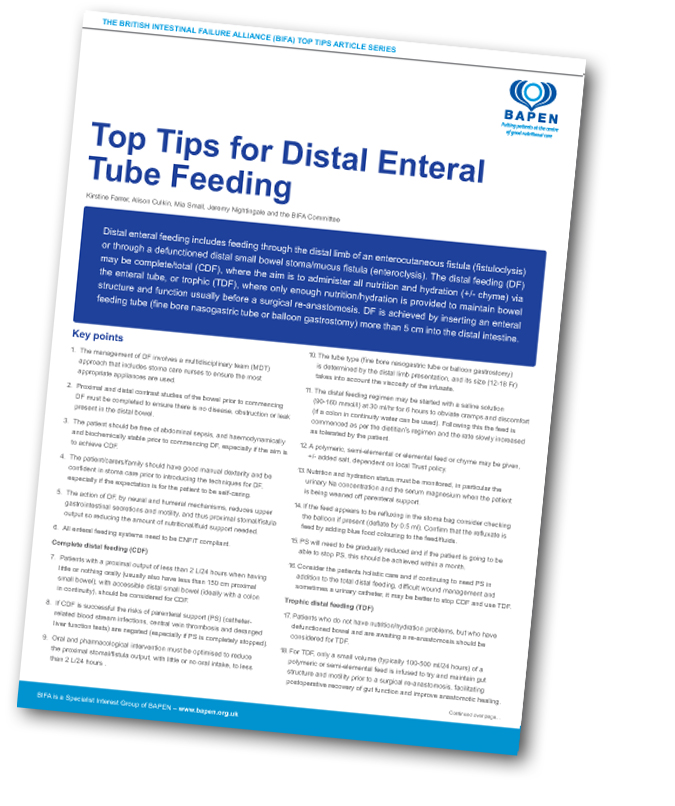
Distal enteral feeding includes feeding through the distal limb of an enterocutaneous fistula (fistuloclysis) or through a defunctioned distal small bowel stoma/mucus fistula (enteroclysis). The distal feeding (DF) may be complete/total (CDF), where the aim is to administer all nutrition and hydration (+/- chyme) via the enteral tube, or trophic (TDF), where only enough nutrition/hydration is provided to maintain bowel structure and function usually before a surgical re-anastomosis. DF is achieved by inserting an enteral feeding tube (fine bore nasogastric tube or balloon gastrostomy) more than 5 cm into the distal intestine.
Click here to download the article.

Top Tips for Discharging a Patient on Home Parenteral Support in England
Kirstine Farrer, Cathy Cawley, Angela Page, Michael Taylor, and the BIFA Committee
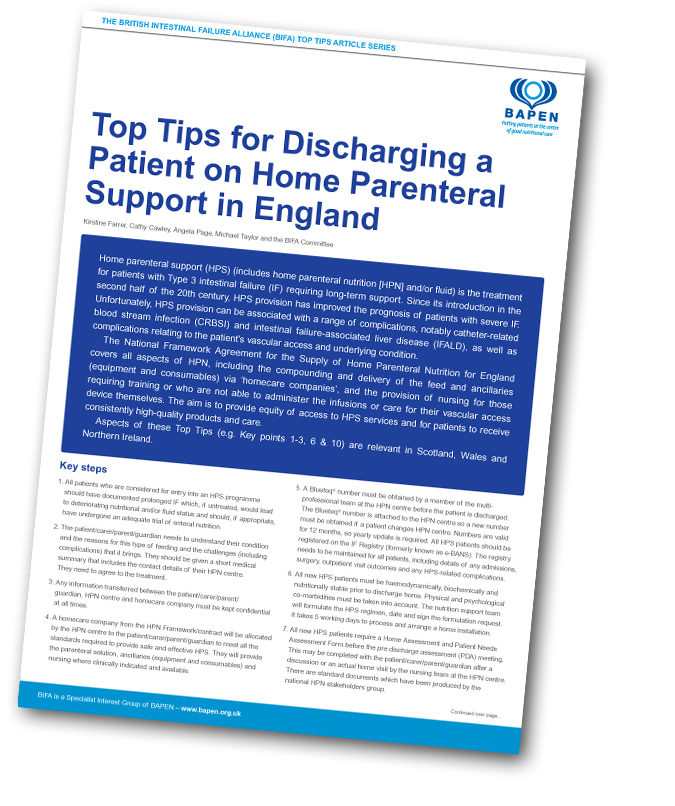
Home parenteral support (HPS) (includes home parenteral nutrition [HPN] and/or fluid) is the treatment for patients with Type 3 intestinal failure (IF) requiring long-term support. Since its introduction in the second half of the 20th century, HPS provision has improved the prognosis of patients with severe IF. Unfortunately, HPS provision can be associated with a range of complications, notably catheter-related blood stream infection (CRBSI) and intestinal failure-associated liver disease (IFALD), as well as complications relating to the patient's vascular access and underlying condition.
The National Framework Agreement for the Supply of Home Parenteral Nutrition for England covers all aspects of HPN, including the compounding and delivery of the feed and ancillaries(equipment and consumables) via ‘homecare companies’, and the provision of nursing for those requiring training or who are not able to administer the infusions or care for their vascular access device themselves. The aim is to provide equity of access to HPS services and for patients to receive consistently high-quality products and care.
Click here to download the article.

Top Tips for Preventing and Managing Refeeding Syndrome
Jeremy Nightingale, Peter Turner, Aminda De Silva, and the BIFA Committee
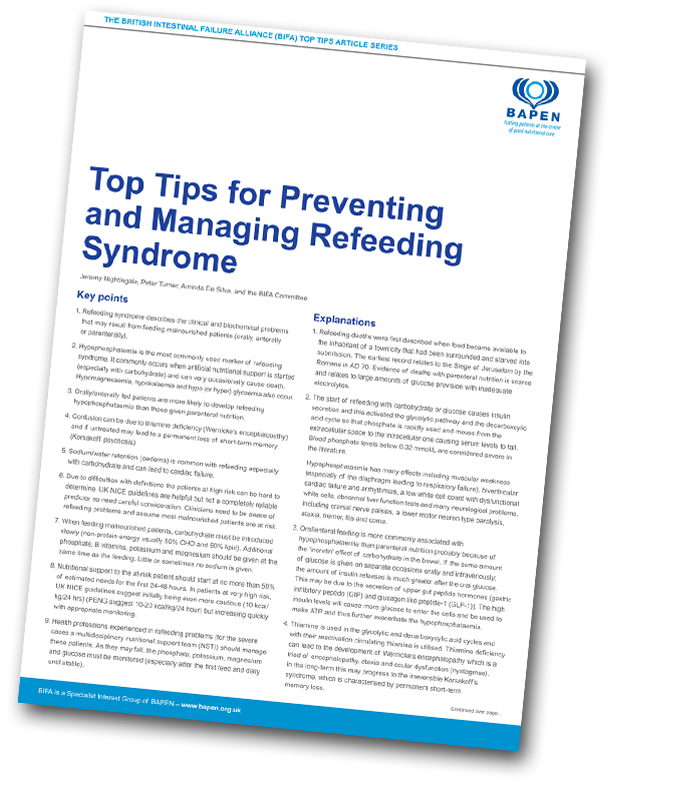
Refeeding syndrome describes the clinical and biochemical problems that may result from feeding malnourished patients (orally, enterally or parenterally).
Click here to download the article.

Top Tips for Managing Catheter-Related Blood Stream Infection in Patients Receiving Home Parenteral Support
Anabelle Cloutier, Simon Lal, Jeremy Nightingale, and the BIFA Committee
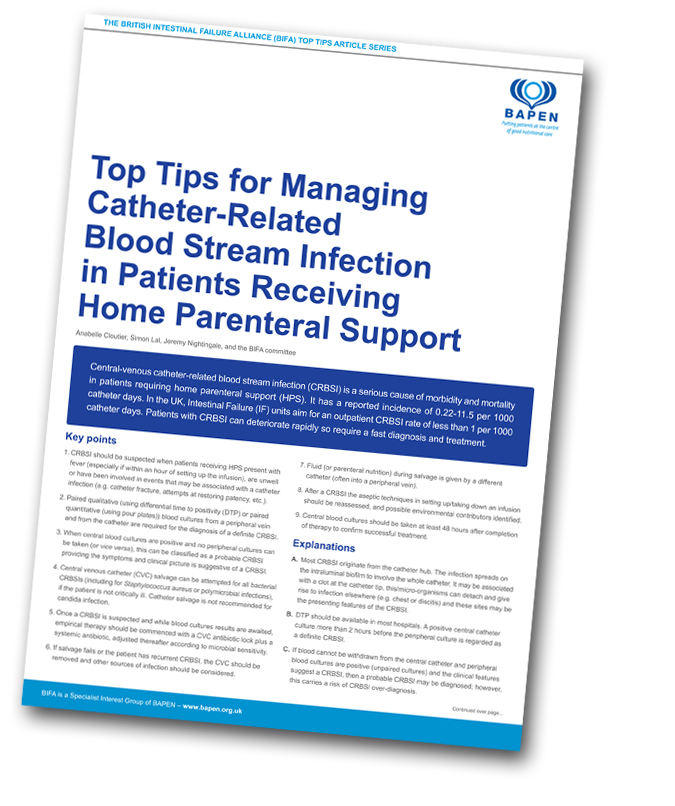
Central-venous catheter-related blood stream infection (CRBSI) is a serious cause of morbidity and mortality in patients requiring home parenteral support (HPS). It has a reported incidence of 0.22-11.5 per 1000 catheter days. In the UK, Intestinal Failure (IF) units aim for an outpatient CRBSI rate of less than 1 per 1000 catheter days. Patients with CRBSI can deteriorate rapidly so require a fast diagnosis and treatment.
Click here to download the article.

Top Tips for Managing Central Vein Thrombosis in Patients Receiving Parenteral Support
Jeremy Nightingale, Simon Lal, Simon Gabe, and the BIFA Committee
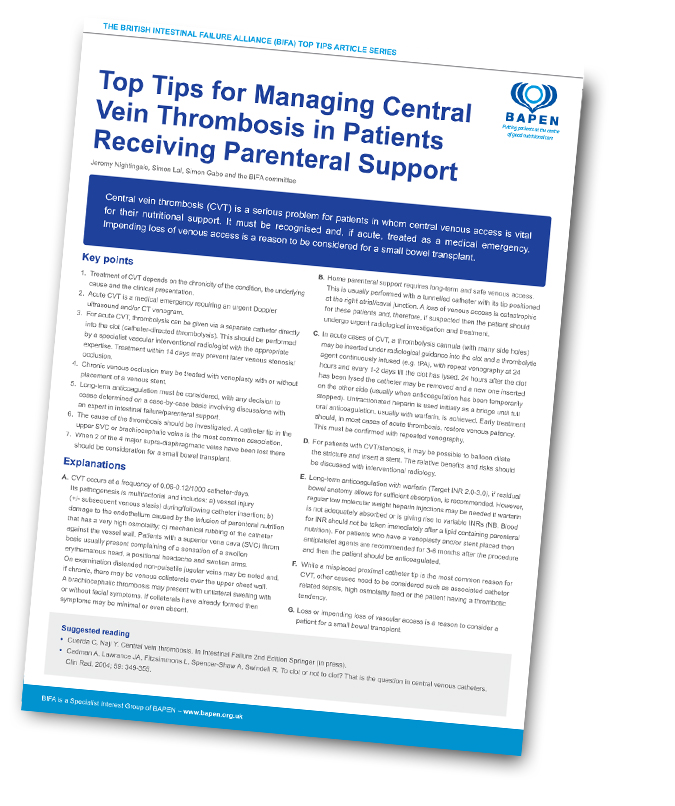
Central vein thrombosis (CVT) is a serious problem for patients in whom central venous access is vital for their nutritional support. It must be recognised and, if acute, treated as a medical emergency. Impending loss of venous access is a reason to be considered for a small bowel transplant.
Click here to download the article.

Top Tips in Adult Intestinal and Multivisceral Transplantation Referral
What, who, when, where and how?
Jeremy Woodward, and the BIFA Committee
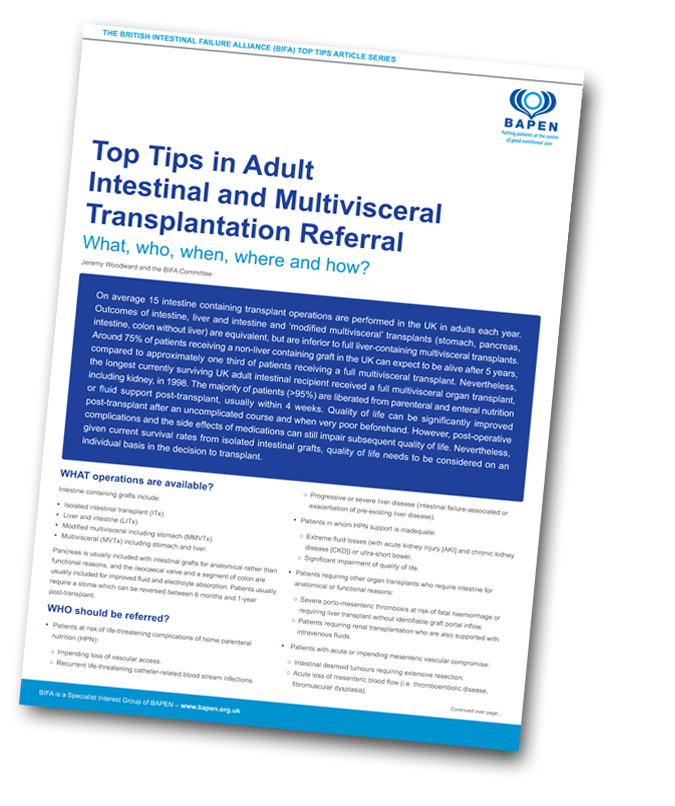
On average 15 intestine containing transplant operations are performed in the UK in adults each year. Outcomes of intestine, liver and intestine and ‘modified multivisceral’ transplants (stomach, pancreas, intestine, colon without liver) are equivalent, but are inferior to full liver-containing multivisceral transplants. Around 75% of patients receiving a non-liver containing graft in the UK can expect to be alive after 5 years, compared to approximately one third of patients receiving a full multivisceral transplant. Nevertheless, the longest currently surviving UK adult intestinal recipient received a full multivisceral organ transplant, including kidney, in 1998. The majority of patients (>95%) are liberated from parenteral and enteral nutrition or fluid support post-transplant, usually within 4 weeks. Quality of life can be significantly improved post-transplant after an uncomplicated course and when very poor beforehand. However, post-operative complications and the side effects of medications can still impair subsequent quality of life. Nevertheless, given current survival rates from isolated intestinal grafts, quality of life needs to be considered on an individual basis in the decision to transplant.
Click here to download the article.

Managing Abnormal Liver Function Tests in Patients Receiving Parenteral Nutrition
Darren Wong, and the BIFA Committee
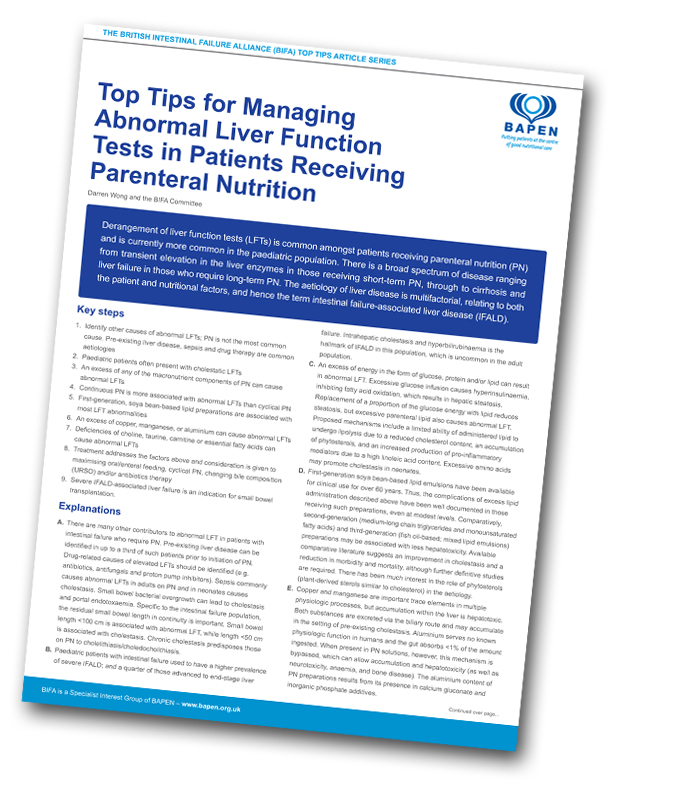
Derangement of liver function tests (LFTs) is common amongst patients receiving parenteral nutrition (PN) and is currently more common in the paediatric population. There is a broad spectrum of disease ranging from transient elevation in the liver enzymes in those receiving short-term PN, through to cirrhosis and liver failure in those who require long-term PN. The aetiology of liver disease is multifactorial, relating to both the patient and nutritional factors, and hence the term intestinal failure-associated liver disease (IFALD).
Click here to download the article.

Managing Children Receiving Long-term Parenteral Nutrition
Julian Thomas, Theodoric Wong, and the BIFA Committee
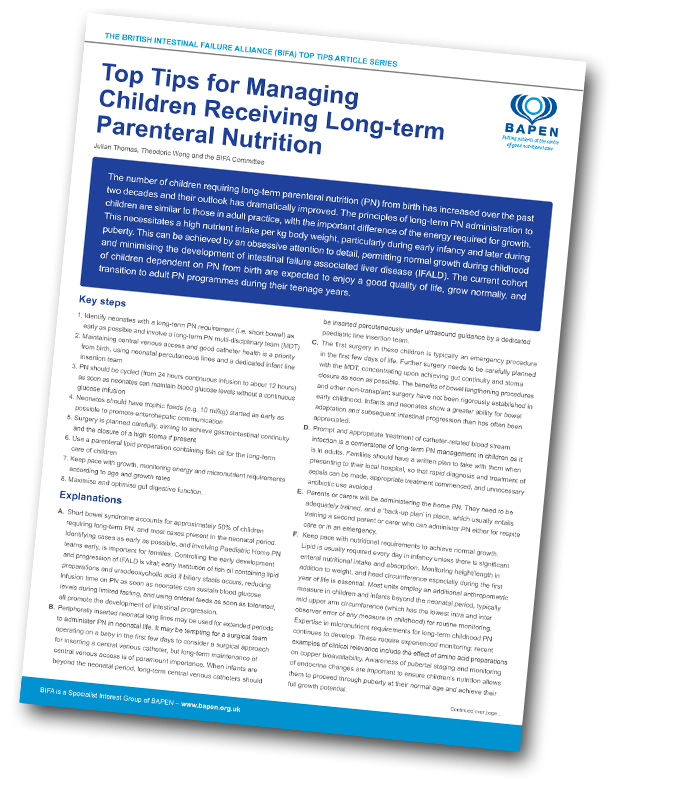
The number of children requiring long-term parenteral nutrition (PN) from birth has increased over the past two decades and their outlook has dramatically improved. The principles of long-term PN administration to children are similar to those in adult practice, with the important difference of the energy required for growth. This necessitates a high nutrient intake per kg body weight, particularly during early infancy and later during puberty. This can be achieved by an obsessive attention to detail, permitting normal growth during childhood and minimising the development of intestinal failure associated liver disease (IFALD). The current cohort of children dependent on PN from birth are expected to enjoy a good quality of life, grow normally, and transition to adult PN programmes during their teenage years.
Click here to download the article.

Managing a High Output Stoma or Fistula
Jeremy Nightingale, and the BIFA Committee
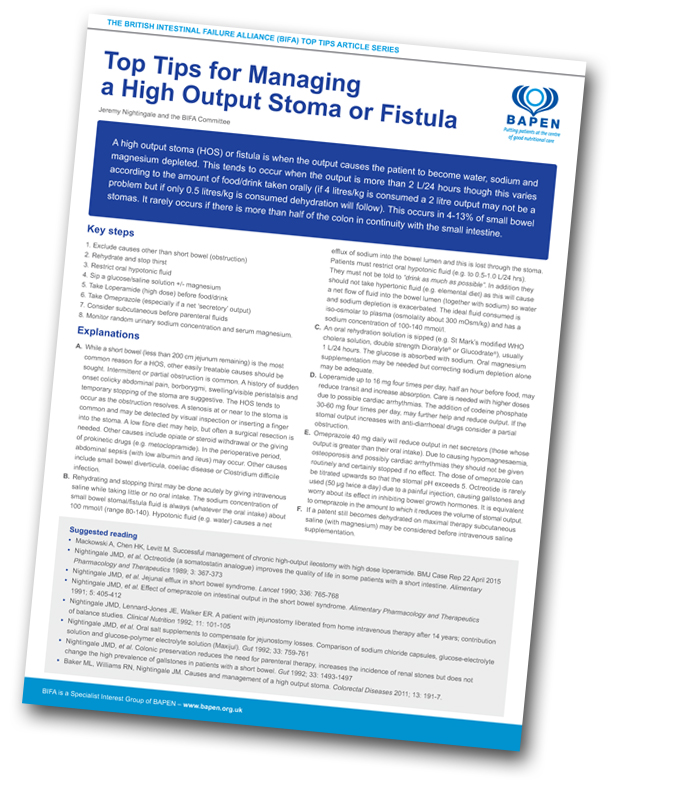
A high output stoma (HOS) or fistula is when the output causes the patient to become water, sodium and magnesium depleted. This tends to occur when the output is more than 2 L/24 hours though this varies according to the amount of food/drink taken orally (if 4 litres/kg is consumed a 2 litre output may not be a problem but if only 0.5 litres/kg is consumed dehydration will follow). This occurs in 4-13% of small bowel stomas. It rarely occurs if there is more than half of the colon in continuity with the small intestine.
Click here to download the article.
